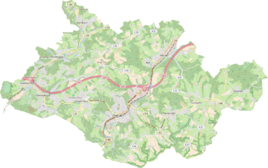Bush (Overath)
|
bush
City of Overath
Coordinates: 50 ° 57 ′ 21 ″ N , 7 ° 14 ′ 27 ″ E
|
||
|---|---|---|
| Height : | 208 m above sea level NN | |
|
Location of Busch in Overath |
||
Busch is a district of Steinenbrück in the town of Overath in the Rheinisch-Bergisches Kreis in North Rhine-Westphalia , Germany .
Location and description
The district of Busch is located on a ridge between the Sülztal in the north and the Holzbachtal in the south. It can be reached via Landesstraße 284, which is called Lindlarer Straße here . The place consists of the two residential areas Altbusch and Busch. While Busch has merged with the village of Neuhurden to form a settlement area, Altbusch is still independent today on the Altbusch street of the same name . Two detached houses on Altbusch Street, built in the 1960s / 70s, complement the Busch settlement area. Places in the near are Müllenholz , Untersteeg and Immekeppelerteich . From a natural perspective, the area belongs to the Sülz plateaus .
history
The Topographia Ducatus Montani by Erich Philipp Ploennies , Blatt Amt Steinbach , shows that the living space had two farmsteads as early as 1715, which are labeled as bush . Carl Friedrich von Wiebeking names the court on his charter of the Duchy of Berg in 1789 as Büsch . It shows that at that time the place was part of the Löderich family in the parish of Overath.
The place is recorded on the topographical survey of the Rhineland from 1817 as a bush . The Prussian first recording from 1845 shows the residential area under the name Büsch . From the Prussian new admission of 1892, the place is regularly recorded as a bush on measuring table sheets .
The place was near Heidenstrasse , an important medieval old road from Cologne via Kassel to Leipzig , today's connecting road to Leffelsend .
In 1822 30 people lived in the place categorized as a courtyard and designated Busch , which after the collapse of the Napoleonic administration and its replacement belonged to the Overath mayor in the Mülheim am Rhein district . For the year 1830 36 inhabitants are given for the place called Busch . The place, which was categorized as a village and designated Busch in 1845 according to the overview of the government district of Cologne , had nine residential buildings with 53 inhabitants, all of them Catholic denominations. The municipal and Gutbezirksstatistik the Rhine Province leads Busch 1871 with six houses and 29 residents.
The list of inhabitants and cattle from 1848 counts 59 inhabitants in Busch, including 33 children under 16 years of age. They are called names and occupations of household heads: Gerhard Hasberg, Johann Rappensberger and Peter Völkenrath ( Ackerer and leaseholders ) - Johann Old Weier, Adolph Muller, Peter Remshachen, Johann Röhrich and Nicolas Schmitt (Ackerer). Johann Pauls, the Wittib Johann Hollinder and Johann Büscher were described as without trade , and Wilhelm Wester and Wilhelm Rick as day laborers . The latter had a family of four to look after, owned a goat and was officially marked as poor , as was the shoemaker Anton Trompeter with his family of six and Johann Pauls, owner of two goats. Johann Büscher received an additional exclamation mark in addition to the comment poor . Völkenrath owned most of the cattle in the village: 1 ox, 2 cows, 1 calf .
In the municipality lexicon for the province of Rhineland from 1888, eight houses with 54 inhabitants are given for Busch . In 1895 the place had eight houses with 41 inhabitants, in 1905 ten houses and 52 inhabitants are given.
Individual evidence
- ^ Wilhelm Fabricius : Explanations for the Historical Atlas of the Rhine Province ; Second volume: The map of 1789. Division and development of the territories from 1600 to 1794 ; Bonn; 1898
- ^ Herbert Nicke : The Heidenstrasse. History and landscape along the historic highway from Cologne to Kassel . In: Land and history between Berg, Wildenburg and South Westphalia . tape 6 . Galunder, Wiehl 2001, ISBN 3-931251-74-8 , pp. 38 f .
- ↑ Alexander A. Mützell: New topographical-statistical-geographical dictionary of the Prussian state . tape 1 . Karl August Künnel, Halle 1821.
- ↑ Friedrich von Restorff : Topographical-statistical description of the Royal Prussian Rhine Province , Nicolai, Berlin and Stettin 1830
- ↑ Overview of the components and list of all the localities and individually named properties of the government district of Cologne: by districts, mayor's offices and parishes, with information on the number of people and the residential buildings, as well as the Confessions, Jurisdictions, Military and former state conditions. / ed. from the Royal Government of Cologne [Cologne], [1845]
- ↑ Royal Statistical Bureau Prussia (ed.): The communities and manor districts of the Prussian state and their population . The Rhine Province, No. XI . Berlin 1874.
- ^ Berthold Gladbach, Peter Lückerath: The Overather population in lists of names, taxes and residents from the 15th to the 20th century, Ed .: Geschichtsverein Rhein-Berg, Bergisch Gladbach 2016. ISBN 978-3-932326-75-2 , p 337
- ↑ Königliches Statistisches Bureau (Prussia) (Ed.): Community encyclopedia for the Rhineland Province, based on the materials of the census of December 1, 1885 and other official sources, (Community encyclopedia for the Kingdom of Prussia, Volume XII), Berlin 1888.
- ↑ Königliches Statistisches Bureau (Prussia) (Ed.): Community encyclopedia for the Rhineland Province, based on the materials of the census of December 1, 1895 and other official sources, (Community encyclopedia for the Kingdom of Prussia, Volume XII), Berlin 1897.
- ↑ Royal Statistical Bureau (Prussia) (Ed.): Community encyclopedia for the Rhineland Province, based on the materials of the census of December 1, 1905 and other official sources, (Community encyclopedia for the Kingdom of Prussia, Volume XII), Berlin 1909

